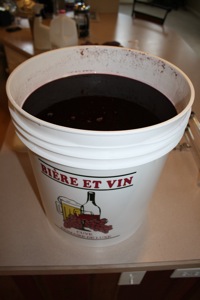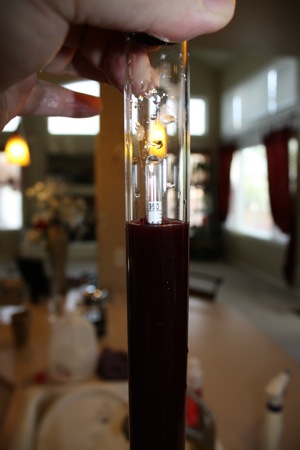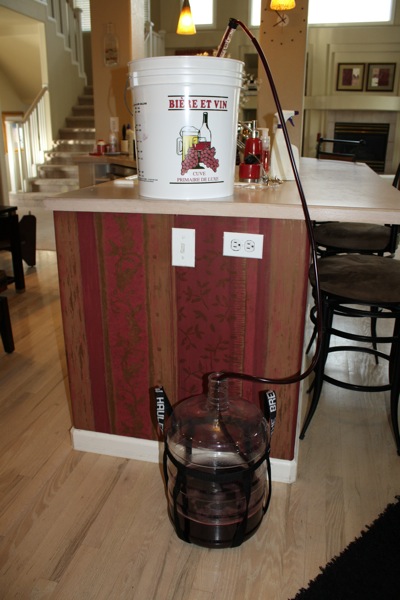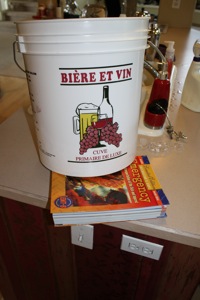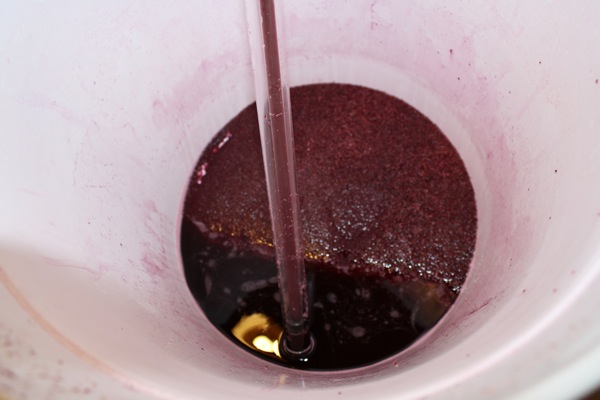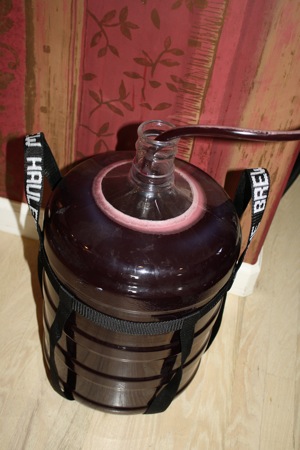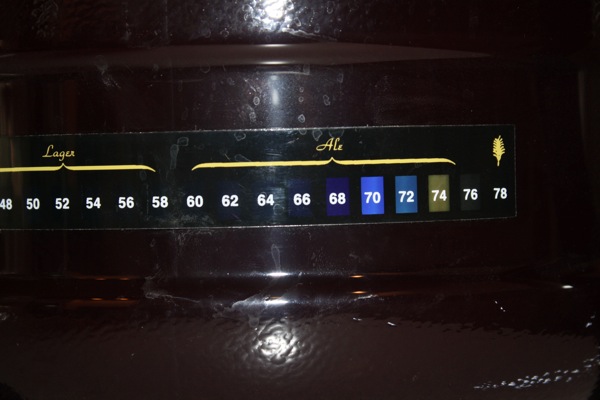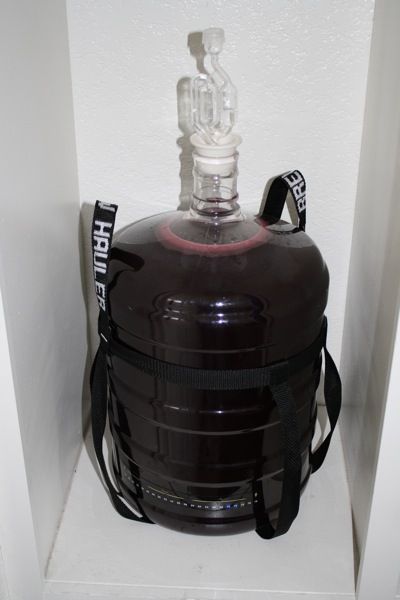
Yea! Today is wine making day. This will be batch three for me, with the first two being an Argentinean Malbec and a big red California Zinfandel. The Malbec, my first, was not so great but from it I learned a lot. I did not get all of the CO2 scrubbed off of it before I bottled it, so it had a carbonated mouth feel. The second batch I made, the Zin was completely yummy but unfortunately is now completely gone... so once again it's wine making day. This time I will blog about all the steps and equipment as I have now become a true fan of making your own wine!
I have to give credit for getting me hooked to a friend that has been making her own wine for several years now. She invited me to a grape pressing party and open house at her new place down by Franktown and I have been hooked ever since. She has since progressed to buying her own grapes in yard lots, and pressing them - hence the pressing party - but she said that she stared with wine kits. The day was very fun and by the end of it I was covered from head to toe in grape must. I think her and her husband are planning on planting some vines soon, so this can be as easy or as difficult as you choose. I like easy and the kits are lots of fun.
I did a little research and found that the local beer brew hut on Chambers and Hampden has all the supplies you need to get started for about $150.00. This includes a 6.5 gallon primary brew bucket, a 6 gallon carboy, long stirring spoon, stoppers and air locks, an auto siphon (very helpful for racking - transferring the wine to another container) and tubing, a hydrometer for measuring the specific gravity, and a bottle filler.


A few other things I have picked up along the way include a second pail, with a spout (makes bottling much easier) a carboy carrier because six gallons of wine is not a light thing and this will save your back. I am using the plastic carboys. I have read that some people will only use the glass ones. They are heaver, break and are much more expensive. I am unsure of the advantage....
Finally, invest in a drill mounted paint stirrer - above - you will thank me later. Primary fermentation is yeast eating the sugar in the grapes and producing ETOH (Good) and CO2 (Bad) - During a later step, you will need to scrub off all the CO2 that you can, so you don't end up with champaign and trying to do that by hand with a long spoon is not very easy.
Today I chose a Cabernet Sauvignon from Chile. The brew store has several kits available ranging in price from about $75 to $150 depending on the grape, region and brand. This one was Selection International and was $109. It will produce about 30 bottles when done or about $3.60 a bottle for very good and definitely drinkable wine.


The kit comes in a box that contains a bag with 6 gallons of grape juice from the vineyard, yeast, oak chips, potassium metabisulphite, a package of isinglass (clarifier), a package of bentonite clay, and some instructions.
The first step is to clean, clean clean - and then when you think everything is clean, clean it one more time. Bacteria is no friend to wine making and can quickly turn your $100 batch of wine into a foul smelling nightmare, so I can't stress this enough. I found the same when Marty and I used to make beer, so take the time, and wash your stuff more than once. There are special cleaning agents available from the brew store that kill wild yeasts and work very well. They also have a no rinse sanitizer that I mix up in batches and keep in an old spray bottle. Spray everything with a good coating of the sanitizer before it touches the grapes. Also, spray the lid to the bag of grapes before you open it, etc. If you are diligent, you will find it pays off in the long run.

Next put two liters of warm water in the bottom of your primary fermenter and mix in the bentonite clay powder. Bentonite has an affinity for yeast and also stays in suspension in the grape juice, not settling to the bottom. This will help your yeast evenly distribute itself across your grape juice and provide for an even fermentation.

Next add the bag of grape juice, being careful to not splash everywhere - grape juice stains everything it touches, including the counter. Wipe up any spills as soon as possible if you want to stay married. Fill the grape juice bag with about a half gallon of water and slosh it around to get every drop of juice and pour that into the bucket. Then fill to the six gallon line with water (I use tap water, as ours tastes pretty good, but the instructions suggest you may want to use bottled water or filtered water from the fridge if yours does not)
Mix will with the spoon (don't forget to sanitize it first) and incorporate the bentonite throughout the grapes.

The next step is to check the specific gravity. The wine thief that comes in the kit is a great little tool and you drop the hydrometer into it and shake it up and down in the bucket. It sucks up the wine until the hydrometer floats and you can get a measurement. Mine is 1.084. This measurement will tell you the sugar / ETOH content in your wine and is how you monitor the fermentation process. As the yeast eats the sugar and produces alcohol, the specific gravity decreases until it is ready, below 0.996. Did I mention that making wine is also lots of fun with a glass of wine in your hand? The only problem is that the longer it takes, the harder the hydrometer gets to read....

Once you have your first hydrometer reading, the next step is to mix in the oak chips that came with the kit. This gives the wine some character and mimics aging in an oak barrel. Some kits come with chips, other with an oak cork screw stick that steeps in the grapes like a tea bag. Some kits also come with elderflowers or other items based on the type of wine you are making.

Mix well to incorporate the oak chips under the surface of the wine. Check the temperature of your grapes, and ensure it is between 65-75 degrees for the yeast to work its magic. It is easiest to modify this by adjusting the temperature of the water you add when topping up to six gallons. Finally sprinkle the packet of yeast onto the surface of the grapes, but do not mix it in.

Place the lid on the primary fermentation bucket (Spray the inside lip well with sanitizer after cleaning, before you close it) and put an air lock into the hole. Place your bucket someplace within your house that maintains a relatively stable temperature between 65-75 degrees. In my case, we have some lockers in our laundry room that work just perfectly. If all goes well, the air lock should begin to bubble (fermentation should start) within 24-48 hours. The wine should remain in this bucket until primary fermentation has lowered the specific gravity to 1.010 or below - about 5-7 days. The lower the temperature, the longer this will take.
Come back next week and we will move to step two - racking and secondary fermentation.
Step two is Here
 Thursday, May 19, 2011 at 6:04PM
Thursday, May 19, 2011 at 6:04PM  Store up to 21 bottles of your best wine under the conditions that the vinter intended with the EdgeStar 21 Bottle Dual Zone Thermoelectric Wine Cooler (model: TWR215ESS). While your wine enjoys the optimal temperature and humidity conditions, you get a wine cooler in one of the most stylish European finishes available with fully digital temperature controls with a blue LED display.
Store up to 21 bottles of your best wine under the conditions that the vinter intended with the EdgeStar 21 Bottle Dual Zone Thermoelectric Wine Cooler (model: TWR215ESS). While your wine enjoys the optimal temperature and humidity conditions, you get a wine cooler in one of the most stylish European finishes available with fully digital temperature controls with a blue LED display.

